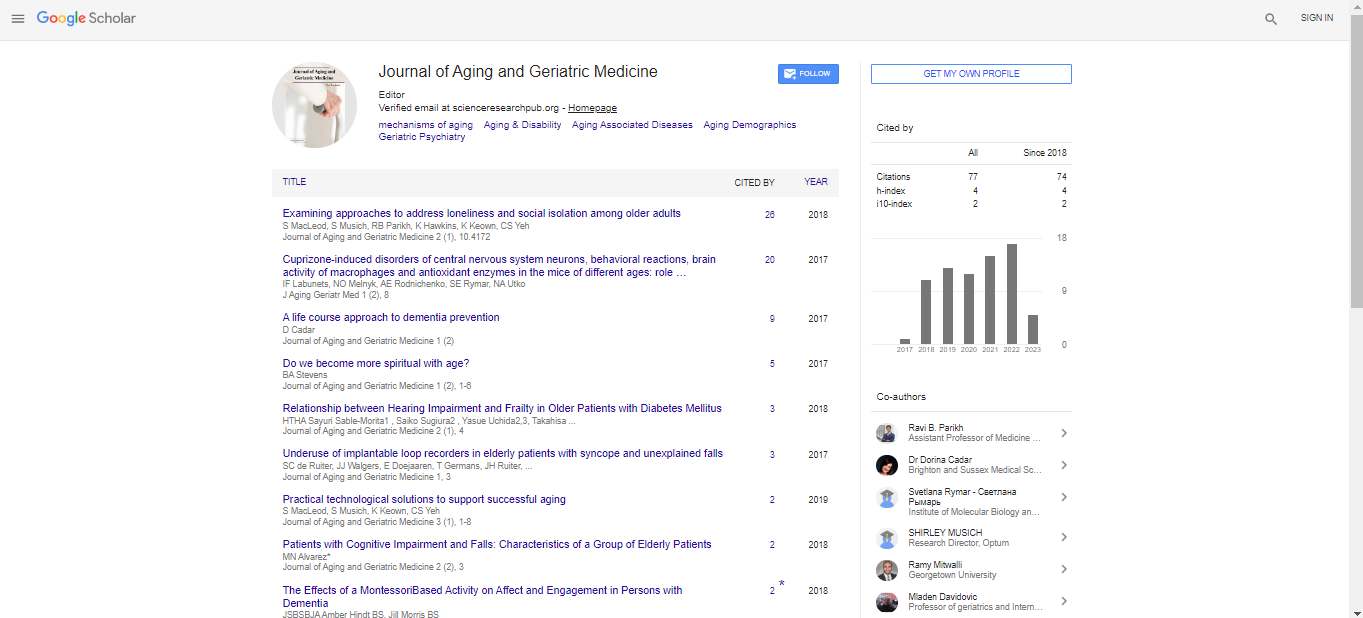Commentary, J Aging Geriatr Med Vol: 7 Issue: 4
Emerging Biomarkers and Diagnostic Tools for Early Detection of Alzheimer's Disease
Bowden Douglas*
1Department of Geriatric Medicine, Radboud University Medical Center, Nijmegen, Netherlands
*Corresponding Author: Bowden Douglas,
Department of Geriatric Medicine,
Radboud University Medical Center, Nijmegen, Netherlands
E-mail: bowdendouglas@mc.nl
Received date: 28 June, 2023, Manuscript No. AGM-23-113040;
Editor assigned date: 30 June, 2023, PreQC No. AGM-23-113040 (PQ);
Reviewed date: 14 July, 2023, QC No. AGM-23-113040;
Revised date: 21 July, 2023, Manuscript No. AGM-23-113040 (R);
Published date: 28 July, 2023, DOI: 10.4172/2576-3946.1000173
Citation: Douglas B (2023) Emerging Biomarkers and Diagnostic Tools for Early Detection of Alzheimer's Disease. J Aging Geriatr Med 7:4.
Description
Alzheimer's Disease (AD) is a progressive neurodegenerative disorder characterized by cognitive decline, memory loss, and behavioral changes. Additionally, it provides an overview of current therapeutic strategies aimed at slowing down disease progression and enhancing the quality of life for affected individuals. Alzheimer's disease is the most common cause of dementia, affecting millions worldwide. Early detection of Alzheimer's Disease (AD) is crucial for timely intervention and improved outcomes. The hallmark pathologic features of AD include the accumulation of Amyloid-Beta (Aβ) plaques and tau protein tangles in the brain. These pathological changes disrupt neuronal communication and lead to cognitive impairment.
Pathogenesis of Alzheimer's Disease (AD)
Advances in biomarker research have led to the identification of molecular and imaging markers that provide insights into the pathological processes of Alzheimer's Disease (AD). The amyloid hypothesis proposes that the accumulation of Aβ peptides, derived from the Amyloid Precursor Protein (APP), triggers a cascade of events leading to neurodegeneration. Aβ aggregates into plaques, inducing oxidative stress, neuroinflammation, and synaptic dysfunction. Tau proteins stabilize microtubules in neurons. In AD, abnormal phosphorylation of tau leads to its aggregation into neurofibrillary tangles, disrupting cellular transport mechanisms and causing neuronal death. Activation of microglia and astrocytes in response to Aβ accumulation leads to chronic inflammation. Inflammatory mediators contribute to neurodegeneration and exacerbate disease progression.
Therapeutic approaches
Anti-Aβ strategies aim to prevent Aβ accumulation or promote its clearance. Monoclonal antibodies, such as aducanumab, target Aβ plaques for immune-mediated clearance. However, challenges include the timing of intervention and potential side effects. Inhibiting tau aggregation and promoting its clearance are under investigation. Small molecules and immunotherapies targeting tau hold promise but face hurdles in effectively crossing the blood-brain barrier.
Neuroinflammation modulation agents aim to mitigate the caused neuroinflammation. However, balancing the immune response is crucial to avoid impairing essential immune functions.
Genetic and biomarker information can guide personalized treatment approaches. Identifying individuals at risk of AD and tailoring interventions accordingly holds potential for improved outcomes. Diet, exercise, cognitive engagement, and social interaction contribute to brain health. Lifestyle interventions can potentially delay cognitive decline and enhance overall well-being.
Neuroimaging biomarkers
Amyloid PET imaging: Positron Emission Tomography (PET) scans with amyloid-specific tracers detect Aβ plaques in the brain. Abnormal amyloid accumulation can be observed even before clinical symptoms appear. Tau-specific PET tracers visualize the distribution of neurofibrillary tangles. Elevated tau accumulation is indicative of neurodegeneration and disease progression.
Aβ and tau proteins: CSF analysis reveals altered levels of Aβ and tau proteins in AD patients. Reduced Aβ42 and elevated tau and phospho-tau concentrations are associated with AD pathology. Elevated plasma NfL levels reflect neurodegeneration and axonal damage. This marker shows promise for tracking disease progression and treatment response.
Neuroinflammation markers: Inflammatory markers, such as cytokines and chemokines, are elevated in AD. Measuring these markers in CSF provides insights into neuroinflammation. Changes in brain structure and connectivity can be detected using MRI. Functional MRI measures neuronal activity and connectivity patterns, offering insights into early functional changes. Combinations of biomarkers from different modalities improve diagnostic accuracy. The National Institute on aging-Alzheimer’s association criteria incorporate both biomarker and clinical information for more precise AD diagnosis.
Challenges and future directions
Developing effective AD therapies faces challenges such as disease heterogeneity, the complex interplay of pathological mechanisms, and difficulties in targeting the brain. Combination therapies, early intervention, and exploring novel drug delivery systems offer avenues for overcoming these challenges. Research is ongoing to identify additional biomarkers and refine existing ones for earlier and more accurate AD diagnosis. Efforts to standardize protocols, establish normative values, and validate biomarker panels across diverse populations are vital for their clinical translation.
Conclusion
Alzheimer's disease remains a significant healthcare challenge with a growing global impact. Understanding the pathogenesis of AD and developing targeted therapeutic strategies are critical for improving the lives of affected individuals and their caregivers. While advances have been made, continued research and collaboration are essential to unraveling the complexity of AD and translating scientific discoveries into effective treatments. Advancements in neuroimaging, CSF analysis, and blood-based assays offer valuable tools for early AD detection. These biomarkers provide insights into the underlying pathology and enable interventions at pre-symptomatic stages. Continued research collaboration is essential to harness the full potential of these tools, ultimately transforming the landscape of AD diagnosis and care.
